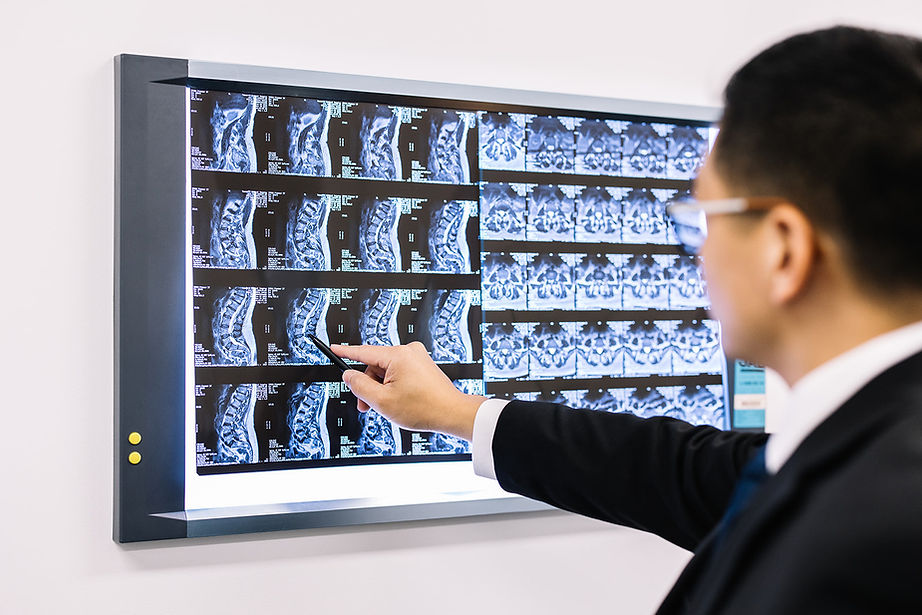Spine Conditions

Back Pain
Back pain is a common and debilitating problem. In your lifetime there is an 80-100% chance of having some form of significant back pain. Luckily the majority of patients are successfully managed without the need for surgery and only simple treatments are required.
During your consultation, we will determine if there is a serious cause for pain and if surgery will help.
Sciatica / Radiculopathy
Pain originating from the neck or the back and running down the arms or legs is called radiculopathy, when it happens in the legs it is given the colloquial term sciatica. The cause of such pain can be compression of the nerves in the spine. This compression can be from several sources but most commonly either a disc herniation or stenosis of the canal from arthritis and age-related changes in the spine.
During your consultation, we will discuss the potential causes and the treatment options both surgical and non-surgical.
Scoliosis
Scoliosis this is a 3-dimensional deformity of the spine commonly thought of as an abnormal curvature of the spine. The majority of these occur without pain and is noticed as a change in the shape of you or your child’s spine/posture. There is a spectrum of severity and causes that need to be determined during the consultation. There are several treatment options from observation, bracing to fusion and vertebral body tethering. We will discuss these options and tailor a solution to you or your child.
Spine Operations Performed
Microdiscectomy
A microdiscectomy is performed to remove a herniated disc fragment that is causing pressure on a nerve root. The surgery involves a small incision in the back and removal of a small amount of bone (laminae) and ligamentum flavum to allow mobilisation of the nerves to extract the disc fragment. You can expect improvement of the leg pain. I advise all my patients to “take it easy” for the next 6 weeks with walking being the main form of exercise and activity. No heavy lifting for 3 months, to help reduce the risk of re-herniation.
Lumbar Decompression
Decompression surgery is performed to alleviate pressure on nerve roots for the treatment of neurogenic claudication. The surgery involves an incision in the back and removal of some bone (laminae) and ligamentum flavum to create more space for the nerves. You can expect improvement of pain in their legs when they walk. After the surgery you are up an walking with the physiotherapist the next day.
Lumbar Fusion
Lumbar fusion surgery is a major surgical procedure to alleviate pain caused by compression of the nerves and instability of the vertebral segments. I tailor my approach to each patient and their individual circumstance. There are multiple ways to perform this surgery, including approaching the spine from the front, side, and the back. When discussing fusion surgery together in the office we will plan the best approach to maximise success and recovery from the surgery.
Anterior Cervical Discectomy and Fusion or Replacement
Anterior Cervical Discectomy and Fusion or Replacement is a specialised procedure to clear away herniated disc material and maybe some bony overgrowth compressing on nerves and/or the spinal cord causing pain and disability. The decision to do a fusion or a disc replacement is dependent on multiple factors that I tailor to each patient individually. I use a microscope through a small incision in the neck to carefully remove the unwanted materials and insert a cage or replacement device.
Posterior Cervical Decompression
In situations where the spinal cord is being compressed across multiple levels, I will perform a decompression from the back of the neck. I create more space for the spinal cord by carefully removing some bone called the lamina. Often associated with this I may need to do a fusion or a laminoplasty. We will discuss the best options during the consultation.
Scoliosis Correction Surgery
Scoliosis correction is a major surgery that can be performed in a variety of ways. The traditional methods through an incision and placement of rods and screws in the back is still the suitable for many patients. There are circumstances where you or your child may benefit from a surgery that is approached from the front/side. Furthermore, there are now relatively new techniques, called vertebral tethering, that involve using a different material for the correction that allow for growth modulation and preservation of flexibility. If you or your child are in the operative category, we will discuss all the available options and tailor our approach to find the best solution.
Postoperative Protocols for Patients
The Incision – Keep this clean and dry for 2 weeks.
Showering – we apply a water-proof dressing, and you can shower after 3 days. If the dressing gets soaked underneath change it with the spares provided Blood thinners – these can usually be recommenced within 36h of the surgery. Be sure to ask me before and after the surgery.
Driving – depending on the surgery this can be between 2-6 weeks. Surgery that involves the neck with a fusion often takes longer as you need to be safe to turn your head.
Physio and Exercise – for most of my surgery I want all my patients moving early. This is simply in the form of walking. There are some specific exercises that the physiotherapist will demonstrate to you before you go home. In certain situations, we may even engage a physiotherapy program prior and after surgery to increase strength and mobility.

Get in Touch
The Orthopaedic Clinic
Suite 16, Level 1, Eastpoint Building, 50 Glebe Road, The Junction
NSW 2291
Sydney Orthopaedic Specialists
Suite 29, Level 7 Prince of Wales Private Hospital, Barker Street, Randwick NSW 2031
My Sports & Joints
Suite 209, Level 2, Strathfield Plaza
11 The Boulevarde, Strathfield, NSW, 2135
Phone: (02) 9650 4770
Email: office@drpatricklim.com